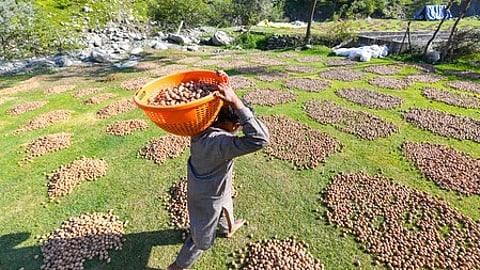

Agriculture remains the backbone of India’s economy, providing livelihoods to nearly half of the population and contributing about 18 percent to the national GDP.
With the country aiming for a 5 percent agricultural growth rate under the vision of “Viksit Krishi aur Samruddh Kisan” (Developed Agriculture and Prosperous Farmer), strengthening education, research, and training has become central to driving productivity and sustainability in the sector.
At the heart of India’s agricultural advancement stands the Indian Council of Agricultural Research (ICAR) — the apex body for agricultural research and education, established in 1929 under the Department of Agricultural Research and Education, Ministry of Agriculture and Farmers Welfare.
ICAR coordinates research and higher education across agriculture, horticulture, fisheries, and animal sciences, overseeing a vast network of 113 national research institutes and 74 agricultural universities.
Through its 731 Krishi Vigyan Kendras (KVKs), ICAR ensures technology transfer to farmers while maintaining academic standards via the ICAR Model Act (Revised 2023) and institutional accreditation through the National Agricultural Education Accreditation Board.
India’s agricultural education landscape is extensive, comprising 63 State Agricultural Universities (SAUs), three Central Agricultural Universities (CAUs) — Pusa, Imphal, and Jhansi — along with four Deemed Universities (IARI-Delhi, NDRI-Karnal, IVRI-Izatnagar, and CIFE-Mumbai), and four Central Universities with agriculture faculties.
Eleven Agricultural Technology Application Research Institutes (ATARIs) further strengthen technology dissemination.
The private sector has also emerged as a growing contributor, with ICAR-accredited private agricultural colleges increasing from five in 2020–21 to 22 in 2024–25, underlining expanding educational participation beyond the public system.
Among the three Central Agricultural Universities, each plays a regional role.
Dr. Rajendra Prasad Central Agricultural University (Pusa, Bihar), converted from Rajendra Agricultural University in 2016, runs eight constituent colleges and offers programs across eight disciplines.
It manages 18 KVKs in Bihar and offers short-term diploma and certificate courses in line with the National Education Policy.
Central Agricultural University (Imphal, Manipur), established in 1993, serves seven northeastern states through 13 colleges and offers 10 undergraduate, 48 master’s, and 34 Ph.D. programs with a total enrollment of nearly 3,000 students in 2024–25.
Rani Lakshmi Bai Central Agricultural University (Jhansi, Uttar Pradesh), set up in 2014, acts as a national centre of excellence in agricultural sciences with constituent colleges in Jhansi and Datia, offering multidisciplinary education and research in agronomy, veterinary science, and agricultural engineering.
India’s agricultural modernization is also being accelerated through emerging technologies like the Internet of Things (IoT) and Artificial Intelligence (AI).
Government initiatives promote precision farming, drones, climate-smart systems, and AI-driven crop monitoring. Under the National Mission on Interdisciplinary Cyber-Physical Systems (NM-ICPS), 25 Technology Innovation Hubs (TIHs) have been set up, including specialized hubs at IIT Ropar, IIT Bombay, and IIT Kharagpur focusing on AI and IoT for agri-tech applications.
The IoT Centres of Excellence in cities such as Visakhapatnam and Bengaluru further link startups, academia, and investors to foster innovation.
Since 2018–19, the Innovation and Agri-Entrepreneurship Development Programme under the Rashtriya Krishi Vikas Yojana (RKVY) has boosted start-ups in agri-tech, agro-processing, AI, IoT, and value-added agriculture, creating rural employment and enhancing farmers’ income.
Farmer training and skill development remain key to India’s agricultural transformation.
Programs such as Skill Training of Rural Youth (STRY), Sub-Mission on Agricultural Mechanization (SMAM), Pradhan Mantri Kaushal Vikas Yojana (PMKVY), and initiatives under KVKs and Agricultural Technology Management Agency (ATMA) continue to build grassroots capacity.
Between 2021–22 and 2023–24, KVKs trained over 58 lakh farmers, with an additional 18.56 lakh trained in the first ten months of 2024–25. ATMA trained nearly 1.27 crore farmers between 2021 and 2025, while STRY trained over 51,000 rural youth in short-term vocational courses.
Under SMAM, more than 57,000 farmers received mechanization training, and the Soil Health Card Scheme distributed over 25 crore cards, backed by 93,000 trainings and 6.8 lakh demonstrations on nutrient management.
To build market-oriented capacity, over 10,000 Farmer Producer Organizations (FPOs) have been registered nationwide, offering digital training on agri-business management, value chains, and marketing.
Together, these efforts combining education, innovation, and farmer empowerment form the foundation of India’s goal of achieving “One Nation – One Agriculture – One Team” and realizing the vision of a Viksit Bharat through a prosperous and sustainable agricultural future.
